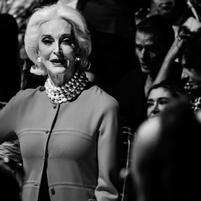I want to talk about the ‘I’ generation. This is the leading edge of the Baby Boomers, who have defined the Western world for the past 50+ years. Influential, based on their numbers alone, throughout their lives they have earned such adjectives as independent, inspirational, intelligent, innovative, industrious, idealistic, intuitive and interesting. Incongruously, now that time and gravity have deprived them of their youthful looks they are ignored, invisible or worse, irrelevant. All their achievements of the past are cast into the abyss, together with their self-esteem. There are two main intersecting issues in my view: loss of personal identity, and ageist stereotyping.
Loss of identity equates with work identity. This is not a new issue. However, the circumstances today are different from the past. Previously, when one retired, one could expect to live five or 10 years, accompanied by failing health. Today, a person retiring at 65 is likely to live another 20 to 25 years, enjoying good health for much of it. Health and longevity aside, the ‘I’ generation does not see itself as old. This is a generation of leaders, who have gone through life empowered. Many want to keep working, or they need to work out of economic necessity. Thus, imagine this type of person being driven out of the workforce.(1)
That brings me to ageism. Paradoxically, even though the ‘I’s (and in this case, the Boomers overall) have been called the ‘most successful, most confident, most individualistic generation that ever-set foot on earth’, this has not exempted them from ageist stereotyping, discrimination or disrespect. A study by AARP, for example, found that 66% of its 37 million members had experienced or witnessed ageism.
Typically, ageist stereotyping includes the perception that, ‘older’ workers’ skills are not up to date, that they want to be paid more, that they will raise insurance costs for their employers because they are more likely to get sick, that they cannot learn new things, are not good with technology and reject new ideas. Employers view them as physically and mentally less fit and stuck in their ways. Nonetheless, there is hope. Slowly we are beginning to see some signs that the ‘I’ generation has lost none of its moxie. As one journalist wrote, ‘This is the generation that wanted to start a social revolution- why would anyone think they want to go gently into the night’?
They have been called the ‘Peter Pan generation’, or ‘high-octane professionals’ who are ‘flunking retirement’. Simply put, many ‘I’s refuse to grow old. For example, the percentage of working Americans over age 65 rose from 12% in the 1990s to 18% in 2016. Many ‘I’s remain engaged. They are involved with universities, charities or corporate boards. Some are self-employed consultants or volunteers. Some just want to ‘live life to the fullest’. As one executive recounted, we are ‘going into unchartered territory’.
The ‘Is’ are pioneering this unchartered territory, as they always have. There is evidence of this. For example, the former editor of the Sunday Times Magazine recently wrote about ‘The joy of being 80-no, really’ in which he listed 80 reasons why he loved his age. In 2017 The Economist wrote about ‘The New Old’, featuring septuagenarian Mick Jagger, arguing that longer, healthier lives have been a boon to economies and societies in addition to individuals. In June this year, the New York Times published an article on ‘The Glamorous Grandmas of Instagram’, with quotes like, ‘We aren’t going to be little old ladies with blue hair sitting in a nursing home’. Fashion magazines like Harper’s Bazaar, now have regular sections on ‘Fabulous at Any Age’. Ads for one cosmetic brand proclaim, ‘our perfect age is now’.(2)
There is a point to this. It is a new world, but we are not ‘there’ yet. Being on the leading edge of anything is never easy. The ‘I’ generation is ahead of the rest of the Boomers, but this is still new. Although the ‘I’s are creating a new model of ageing, refusing to be defined by the existing cultural norms, they are paying a price. Some say they are confused, in denial and have ‘hybrid’ identities, or are pathetically trying to hang on to lost youth. However, remaining relevant, rejecting invisibility, refusing to be ignored, defying ignorance- these constructs are being turned on their head by the ‘I’s, who in scores are declining to be labelled. The momentum is growing and will unquestionably become the new norm. The next generation is unlikely to experience the same degree of stereotyping, ageism and rejection that the ‘I’s have.
Many call for a redefinition of ‘old people’. They speak to the importance of changing people’s attitudes, keeping people in the workforce longer and maintaining better health. This is all proper thinking, but it is not what is going to drive real change. It is going to take people who are willing to jump into the arena and make their voices heard, refuse to accept the status quo and challenge it. The ‘I’s are not waiting for change, they are causing change. They are the change, and we will all benefit from it. This is not only a quality of life issue. Independence equates with government savings as much as it does with dignity and respect. Thus, the ‘I’ generation should be applauded and celebrated. They are starting yet another social revolution.
(1) Many such cases are profiled in the media. For example, see Weisman, Robert, ‘Help wanted, but not from older workers: Many struggle to find jobs as employers’ post openings’, Boston Globe, June 15, 2018. (Most cannot get jobs and are never told why. Those who do are likely to be employed part time, paid a minimum-wage with no benefits, and work at jobs that are beneath their education, skills or ability, reporting to someone half their age who they do not respect and who does not respect them.)
(2) One of the most famous models in the world, Carmen Dell’ Orefice, is 74 and 94-year-old Iris Apfel has re-emerged as a fashion icon. There are dozens of ‘I’ men and women in show business and politics who are active and working and tens of thousands of other ‘I’s working in a wide range of jobs and professions.
About the Author
Patricia O’Neill (DPhil) is an alumnus of the Oxford Institute of Population Ageing. She is currently a Visiting Academic at Contemporary China Studies (SIAS), Oxford University and an Associate in Research, Fairbank Center of Chinese Studies, Harvard University.
Comments Welcome:
We welcome your comments on this or any of the Institute's blog posts. Please feel free to email comments to be posted on your behalf to administrator@ageing.ox.ac.uk or use the Disqus facility linked below.
Opinions of the blogger is their own and not endorsed by the Institute
Comments Welcome: We welcome your comments on this or any of the Institute's blog posts. Please feel free to email comments to be posted on your behalf to administrator@ageing.ox.ac.uk or use the Disqus facility linked below.













